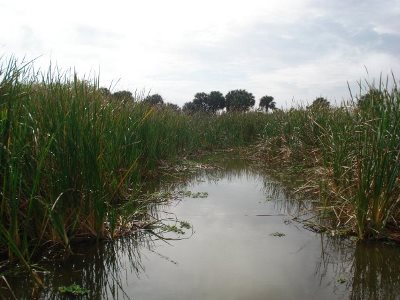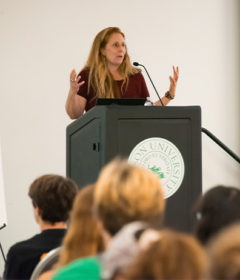Water: Conservation, Regulation top issues
 Let’s put it this way. Unless Florida takes significant steps to conserve, reuse and look for alternative supplies, the state’s fresh water supplies will not meet the needs of its ever-growing population.
Let’s put it this way. Unless Florida takes significant steps to conserve, reuse and look for alternative supplies, the state’s fresh water supplies will not meet the needs of its ever-growing population.
That’s according to almost 60 participants at a recent St. Johns River Basin Supply Workshop held on the Stetson campus. These Central Florida water and energy officials and members of the St. Johns River Alliance, including former Volusia County councilman, Stetson alumnus and visiting professor Clay Henderson ’77, as well as several members of Stetson’s administration, faculty and staff, outlined the scope of the water problem and what might be done about it.
“Under Florida law, water is technically free,” explained Associate Professor J. Anthony Abbott, Ph.D., chair of Stetson’s Environmental Science and Geography program. “But the conditions needed to maintain a consistent supply in the face of growing demand require resources. This is why a shared vision on regulation is required.”
Tom Bartol, assistant director of the St. Johns River Water Management District, discussed the scope of the problem.
“Our population is expected to grow by 38 percent over the next 20 years,” he said. “Water demand projections exceed groundwater availability by about 250 million gallons a day.”
Putting all this into perspective was water expert and Stetson Associate Professor of Biology Kirsten Work, Ph.D.
“The Floridan Aquifer underlies multiple counties and municipalities and provides the majority of the drinking water for much of Florida’s population,” she explained. “As Tom Bartol pointed out, our projected population growth will put additional strain on the freshwater resources in the aquifer.”
Abbott agreed. “While the per capita efficiency of water use has been improving over time in Central Florida, the rapid population growth has pushed us nearly to the limit of sustainable use,” he said.
Other concerns were raised at the meeting. Lisa Rinaman, St. Johns Riverkeeper, said that 60 percent of water is used to water lawns. “Enforcement of water regulations is almost nonexistent,” she said. “Every drop counts. We need more incentives for water conservation and stricter regulations.”
Why not take more water from our rivers? “Our rivers are already in distress,” Rinaman pointed out. “Algae and the toxicity levels in our rivers have already risen dramatically.”
What’s the solution? Restoration and conservation, according to Work. “And if we reduce our reliance on aquifer water for lawn watering, we would have more for drinking,” Work said.
Karen Ryan, Ph.D., dean of Stetson’s College of Arts and Sciences, and professors Work and Abbott are thankful for the continued meetings about Central Florida’s freshwater. “Because policy on environmental management follows science, it is important for leaders to come together to discuss the implications of the latest findings,” Work said.
“We are pleased that Stetson could host this event and that our faculty and students could be involved in the workshop,” Dean Ryan said. “This is a prime example of community engagement and collaborative problem-solving, learning experiences we prize here at Stetson. It’s wonderful to have so much expertise in water management and conservation assemble on the campus; Stetson can and must be a key player in resolving the issues discussed at the workshop.”
By Bill Noblitt
(Photo, courtesy of the St. Johns River Alliance website.)



